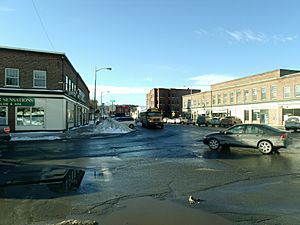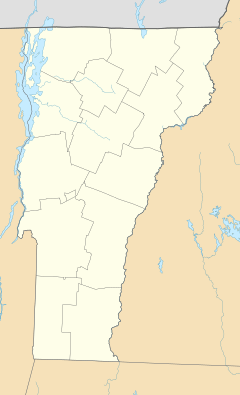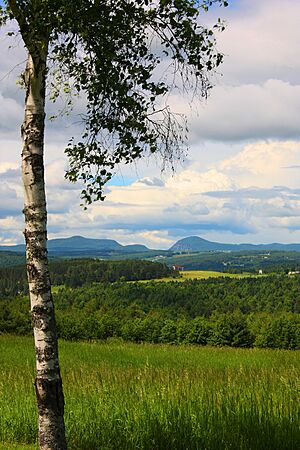Lyndonville, Vermont facts for kids
Quick facts for kids
Lyndonville, Vermont
|
|
|---|---|
|
Village
|
|

Depot Street
|
|
| Country | United States |
| State | Vermont |
| County | Caledonia |
| Town | Lyndon |
| Area | |
| • Total | 0.73 sq mi (1.90 km2) |
| • Land | 0.71 sq mi (1.83 km2) |
| • Water | 0.03 sq mi (0.07 km2) |
| Elevation | 722 ft (220 m) |
| Population
(2020)
|
|
| • Total | 1,136 |
| • Density | 1,556/sq mi (597.9/km2) |
| Time zone | UTC-5 (Eastern (EST)) |
| • Summer (DST) | UTC-4 (EDT) |
| ZIP code |
05851
|
| Area code(s) | 802 |
| FIPS code | 50-41950 |
| GNIS feature ID | 1458324 |
Lyndonville is a small village located in the town of Lyndon. It is found in Caledonia County, Vermont, United States. In 2020, about 1,136 people lived in Lyndonville.
Contents
History of Lyndonville
In 1883, the village leaders bought a hand-powered fire engine. This was the start of their fire department. The volunteers called themselves the "Tiger Fire Company No. 1." They even wore special uniforms for parades starting in 1889.
In 1931, a newspaper in Boston wrote about Lyndonville. It said the town had become a safe place for "Rum Running Gangsters!" These were people who illegally sold alcohol during a time called Prohibition.
In 2023, Governor Phil Scott signed a new law. This law will combine the village government with the town government of Lyndon. This means Lyndonville will no longer have its own separate village government.
Geography and Location
Lyndonville is a small area, covering about 1.9 square kilometers (0.73 square miles). Most of this area is land, about 1.8 square kilometers (0.71 square miles). The rest is water, mainly from the Passumpsic River. This river flows along the western side of the village.
Lyndonville is located about 8 miles (13 km) north of St. Johnsbury. It is also about 35 miles (56 km) south of Newport, Vermont. A main road, U.S. Route 5, goes right through the village center. A bigger highway, Interstate 91, goes around the west side of the village. You can get to Lyndonville from Exit 23 on Interstate 91.
Population and People
| Historical population | |||
|---|---|---|---|
| Census | Pop. | %± | |
| 1880 | 788 | — | |
| 1890 | 606 | −23.1% | |
| 1900 | 1,274 | 110.2% | |
| 1910 | 1,573 | 23.5% | |
| 1920 | 1,878 | 19.4% | |
| 1930 | 1,559 | −17.0% | |
| 1940 | 1,444 | −7.4% | |
| 1950 | 1,506 | 4.3% | |
| 1960 | 1,477 | −1.9% | |
| 1970 | 1,415 | −4.2% | |
| 1980 | 1,401 | −1.0% | |
| 1990 | 1,255 | −10.4% | |
| 2000 | 1,227 | −2.2% | |
| 2010 | 1,207 | −1.6% | |
| 2020 | 1,136 | −5.9% | |
| U.S. Decennial Census | |||
In 2010, there were 1,207 people living in Lyndonville. These people lived in 556 different homes. About half of these homes (276) were families.
Most people in the village were White (95.3%). There were also smaller groups of African American, Native American, and Asian people. Some people were of two or more races. About 2.1% of the population was Hispanic or Latino.
In terms of age, about 19.6% of the people were under 18 years old. About 15.7% were 65 years or older. The average age in the village was about 32.7 years old.
Economy and Jobs
Money and Income
From 2007 to 2011, the average income for a household in Lyndonville was about $34,250 per year. For families, the average income was around $37,351. Some people in the village had lower incomes. About 19.7% of all people, and 15.5% of those under 18, lived below the poverty line. This means they had very low incomes.
Local Industries
The Dairy Association Company is located in Lyndonville. They make a well-known product called Bag Balm.
Another company, Kennametal, used to employ 200 people in the area. However, this company closed down in 2014.
Fun and Tourism
Lyndonville has hosted a community fair every year since 1932. It's a long-standing tradition! In 2009, Boston magazine even called Lyndonville one of the "Best Small Towns" in New England.
Education in Lyndonville
Lyndonville has several schools for different age groups:
- Elementary school: Lyndon Town School
- High school: Lyndon Institute
- College: Northern Vermont University-Lyndon
Arts and Culture
The town has a special bronze statue. It's a copy of the Florentine Boar by Tacca, which is a famous statue in Italy. This statue also works as a fountain, with water flowing from the pig's mouth. Because of this, locals jokingly call it the "puking pig."
Notable People
- Walter H. Cleary: He was a very important judge, serving as the Chief Justice of the Vermont Supreme Court.
- Moses Pendleton: A famous choreographer who started the dance company Momix.
- Ashley Wheeler: She was crowned Miss Vermont in 2008.
See also
 In Spanish: Lyndonville (Vermont) para niños
In Spanish: Lyndonville (Vermont) para niños



